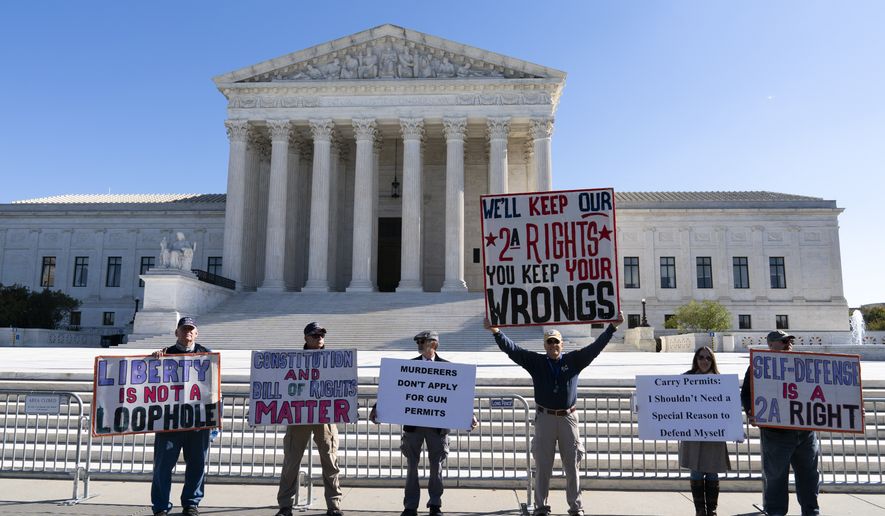The Supreme Court split along ideological lines during a hearing Wednesday on a case involving the right to carry a firearm outside the home — the first major Second Amendment challenge before the high court in more than a decade.
The Republican-appointed wing on the court appears ready to strike down a New York law that requires citizens to show good cause for obtaining a license to carry a firearm.
Challengers to the restriction argued no other constitutional rights are subject to proving to a government official that there is a specific need before being able to exercise the right.
“Carrying a firearm outside the home is a fundamental constitutional right. It is not some extraordinary action,” said Paul Clement, the attorney representing two New York men who were denied licenses.
The case arose after Robert Nash was denied his license despite pointing to a string of robberies in his neighborhood and verifying that he had taken an “advanced firearm training course.”
Brendan Koch, similarly, applied for a license, noting his “extensive experience” with handling firearms in a safe manner.
But New York officials denied both men their licenses, saying they did not show a “proper cause” for carrying a gun in self-defense.
The men and the New York State Rifle and Pistol Association sued over the right to keep and bear arms outside the house.
Mr. Clement argued New Yorkers should enjoy the right to carry a firearm outside the home as citizens do in dozens of other states.
He also argued the regulation is unlawful because the state handles hunting licenses in a less restrictive manner, noting with a license to carry permit, officials want individuals to show a specific need for self-defense that separates them from others in the community.
“We are asking the regime to work the same way for self-defense as it does for hunting,” he said.
Barbara Dale Underwood, the solicitor general of New York, defended the state law, noting states had different requirements for firearms dating back to the early 1800s.
“New York is not an outlier,” she told the court.
Ms. Underwood also argued that there are areas of New York that are densely populated, supporting the need for the law.
“Where there is dense population, there is a deterrent of lots of people,” she said.
But Chief Justice John G. Roberts Jr. did not buy that argument, suggesting there could actually be more crime in densely populated areas and a need for self-defense.
“How many muggings take place in the forest?” Justice Roberts asked.
Brian Fletcher, deputy solicitor general of the United States, also appeared before the justices, siding with New York.
He bolstered the state’s claim that in densely populated areas, there are more police, so allowing others to also carry firearms could cause encounters between the two.
The court’s three Democratic-appointed justices looked with skepticism on the challengers, suggesting there’s history to support such restrictions on guns.
Justice Sonia Sotomayor said there are laws and regulations for states to look at and select from in adopting and implementing restrictions.
“States get a lot of deference on this,” she said.
Justice Stephen G. Breyer also showed his cards, appearing to support the state’s licensing scheme.
“They are dangerous, guns,” Justice Breyer said.
It’s been about a decade since the justices grappled with the limits of the Second Amendment.
In District of Columbia v. Heller, the high court ruled 5-4 that it was unlawful for D.C. officials to restrict the possession of firearms inside the home.
At the time, the makeup of the high court was much different. Five of the justices who took part in considering the Heller case are no longer on the bench.
Justice Roberts, Justice Clarence Thomas, Justice Samuel A. Alito Jr. and Justice Breyer were all on the court at that time — and they still remain on the bench. All but Justice Breyer ruled against the District of Columbia’s restriction.
Justice Brett M. Kavanaugh, meanwhile, was on the U.S. Circuit Court of Appeals for Washington, D.C., at the time where he sided against another one of the district’s regulations, which banned semiautomatic rifles and limited magazine capacity.
Progressives are worried that his stance suggests he is a Second Amendment advocate, along with Justice Amy Coney Barrett, who while on the U.S. Circuit Court for the 7th Circuit sided with a felon who wanted to possess a firearm, noting he was nonviolent.
A ruling in the New York case is expected by the end of June.
The case is New York State Rifle Pistol Assn. v. Bruen.
• Alex Swoyer can be reached at aswoyer@washingtontimes.com.




Please read our comment policy before commenting.